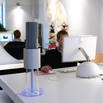- 3 reads

With the colder months ahead, most people are going to be spending more time indoors. Unfortunately, many homes and business suffer from poor indoor air quality that is, on average, two to five times worse than outdoor air quality. While government addresses issues of outdoor air quality, we are responsible for addressing the air quality inside of our homes.
While dust may cause a few sniffles and sneezes, there are other contaminants in the air of your home or workplace that can cause or aggravate serious health conditions. The amount of material in the air indoors is simply staggering. Though you might be aware of the significant amount of dust, pet fur, or strange odors, according to the American Lung Association this is really just the tip of the iceberg. The air in an average home could have biological contaminants like mold, bacteria, or viruses as well as the more noticeable pet dander and fur. These contaminants, which make people uncomfortable or sick, are a leading cause of “sick days” from work.
Another common indoor contaminant is formaldehyde. You might not know that an incredible number of building materials and furniture contain this harmful chemical. Most common is a formaldehyde resin applied to wooden furniture and cabinets. The low vapor pressure of formaldehyde means that it slowly outgases into the air over a period of months or years Formaldehyde causes irritation of the nose, eyes, and throat, as well as skin rashes, vomiting, nausea, and nosebleeds.
The beneficial air cleaning technology, either a free-standing unit or whole home system, can work wonders by substantially improving your indoor air quality. At Working Wonders we’ve researched different air cleaning technologies and chose to market and sell the IQAir series of air purifiers. Forty years of Swiss engineering have gone into these units, which have been chosen by many hospitals around the world. We were especially impressed by the fact that the Hong Kong government tested many different units and the results had them choose to place IQAir products in their hospitals during the SARS epidemic. IQAir was even used at the Beijing Olympics in 2008 to filter gases, fine particulates, and coarse particulates out of the air to improve athlete comfort and performance.
An effective air cleaning system or unit does not cover one smell with another or simply re-circulate contaminated air. With a series of filters, including a HEPA filter for bacteria and viruses, IQAir units trap particles as small as 0.003 microns in size, removing them from the air. This is small enough to even filter out airborne viruses, including the H1N1 virus, commonly known as Swine Flu. While people suffering with allergies and asthma often feel immediate relief in an indoor environment where they is quality air cleaner at work, everyone benefits from offending particulates being removed from the air we breathe.
There are a number of air cleaners on the market so how do you choose one that is right for you and your home or business? Here’s the checklist we use:
- Choose an effective technology that is derived from million-dollar filtration installations used in cleanroom, airport and hospital applications.
- Only use technologies for air cleaning which do not produce any undesirable by-products, such as ozone, charged particles or chemicals.
- Choose user-friendly, low maintenance technologies that signal you when filters need to be replaced.
If you would like more information on our IQAir cleaning technology please feel free to visit our website at www.workingwondersUS.com.
BethAnn Lederer, LEED AP is the founder of Working Wonders, a company that offers a “one-stop” source where design-build professionals and consumers alike can quickly and easily find aesthetically pleasing eco-responsible products, knowledge and services to build out, furnish and accessorize green projects, homes and workplaces. BethAnn speaks and writes about the links that exist between human health and the products we choose to furnish and accessorize our homes and workplaces. Her perspective comes out of a former career in healthcare education, marketing and advocacy.

